
Equestrian Statue of George Washington
Fun Facts about the picturesque statue of George Washington

The Equestrian Statue of George Washington is a beautiful statute of George Washington in the Boston Public Gardens. Many tourists use the statue as a background in their Boston photos.
When was the statue unveiled?
The Equestrian Statue of George Washington was unveiled at a small ceremony on Saturday, July 3, 1869, at 5:30 pm. This unveiling was close to the 70th anniversary of George Washington's death.
Former Mayor Alexander Hamilton Rice, the chairman of the George Washington Statue committee, spoke at the ceremony.
Who paid for it?
The statue was paid for by a mix of public and private funds. Most of the money was raised at a fair in 1859. The fair, called the "Washington Statue Fair", raised $10,000 in only eight days. The entire project cost $42,000, of that $34,000 was raised in private funds.
$42,000 was a lot of money in 1859, that's equivalent to more than $7,000,000 dollars today!
Who designed/created it?
Thomas Ball was the sculptor. The Washington Statue Committee wanted a local artist to do the work.
In 1880, Thomas Ball published an autobiographical book, My Threescore Years, which he updated in 1890 as My Three Score Years and Ten. In his autobiography, he provides ???A brief history of the equestrian statue of Washington."
Some things I learned from reading his Autobiography:
He attended the ceremony and was honored for his work with the status.
The horse that he used was Colonel T. Bigelow Lawrence???s Black Prince, the mount ridden by the young Prince of wales for the military reception on the Commons during his 1860 visit.
Early on during the planning, a group of prominent citizens were impressed with Thomas Bell work and had a hard time deciding if he deciding if should put together a statue of Daniel Webster or George Washington. It was decided that the Washington Statue was the more appropriate.
Thomas Ball was asked to create the Minuteman statue in Lexington, Massachusetts. The town had just about finished raising money for the project when the civil war broke out. After the war, the town had to start again because many key investors died in the war. The town evidently awarded the contract to Daniel Chester French.
In 1900, Daniel Chester French created a statue for Washington in Paris.
Location of the Statue
The Statue is located in the Boston Public Gardens, near Commonwealth Ave and Arlington Street. The statue greets people as they enter in the Public Gardens from Commonwealth Ave.
The nearest T stop is the Green Line (Arlington Station.)
Misc Information
George Washington first appeared on the dollar bill in 1869.
One person in attendance during the unveiling - Timothy Dodd, actually saw George Washington in Hartford, CT when he was 15 years old.
The Great Elm on Boston Commons was still standing when the Equestrian Statue was placed in the Boston Public Gardens. (It came down 7 years later)
The model for this statue is held by the Boston Athenaeum. You need to be a member of the Boston Athenaeum to see the model.
Total height of the monument is 35 feet, of which 16 feet is taken up by the pedestal.
The figure of Washington is 2,000 pounds, and the weight of the horse is 5,000 pounds. The entire weight of the monument is 10,500 pounds.
The garden beds around the statue are always changing. If you visit around Mothers day you'll be sure to see blooming tulips.
The face of Washington looks towards the West. If you plan on taking pictures, your better off seeing the statue in the afternoon. (The face won't be in the shade.)
The Washington Statue is one of the most popular photo spots in the Boston Public Gardens. Other spots nearby include the Make Way for Ducklings and the Swan Boats from the Lagoon bridge. Nearby is the Boston???s 9/11 memorial, Ether Monument, and the park bench that Robin William sat on in the ???Good Will Hunting??? movie.
Letter to Boston
The following letter was given to the mayor at the ceremony as formal declaration that this statue is for the people of Boston.
Boston, July 1, 1869
Hon Nath'l B. Shurtleff, Mayor of Boston.
Sir, - The Washington Statue Committee, a corporation under the laws of the Commonwealth, composed of the following named persons: Alexander H. Rice, Thomas Russell, Francis A Underwood, Warren Sawyer, George H, Chickering Benjamin S. Rotch and George Wm Wales, has this day voted to authorize it officers to convey the equestrian statue of Washington, by Thomas Ball, executed in bronze, and the pedestal upon which it now stands in the Public Garden, to the City of Boston, to be held in trust for its citizens forever, as an ornament to the public grounds. By virtue of this authority, the undersigned respectfully convey said statue and pedestal, through you, to the City of Boston, in accordance with the terms of said vote; as we remain your ob't servants, Alexander H. Rice, Presiden. John D.W. Joy, Treasurer. F. H. Underwood, Secretary.
PermalinkCitgo Sign in Kenmore Square

High above the streets of Kenmore Square in Boston's Back Bay is the famous Citgo Sign. The sign has been lighting the Back Bay night sky for roughly 76 years.
The sign get's most of its notoriety from the Red Sox TV coverage. You see it on TV every time someone hits a home run over the green monster.
The sign was installed in 1940 on top of the building on 660 Beacon Street. In 1940, there was a Cities Service Station on the ground floor.
Things I learned about the Citgo sign.
The sign is 200 feet above street level and the red light can be seen as far way as the hills in Belmont - about 10 miles away.
The sign is 60 feet by 60 feet.
The sign is approximately 1,200 feet from Fenway's Home plate.
In 1976, the lighting hours was reduced from all night to 9 pm to 11 pm to conserve energy.
Sept. 4, 1979, Governor Edward King, ordered the sign to be turned off as part of energy crisis.
The sign was off for 4 years. At the time, it cost Citgo $60 a week to have the lights on.
In 1981, after years of neglect, Citgo announced that they were removing the sign, but was met with a public outcry. On November 16, 1982, as workers were moving tools to the roof they were stopped by the commission's cease and desist order.
In 1982, ten voters petitioned the Boston Landmark Commission to make the Citgo sign a landmark. It was denied on January 25, 1983.
CITGO had agreed to spend $450,000 to keep the sign maintained and shining brightly for at least three years.
On August 10, 1983, just before 9:30 p.m., the sign was re-lit.
CITGO saved $12,300 by having the lights off. (Sign was off for a total of 205 weeks and 2 days)
The sign is not designated a protected national historic landmark or on a National Register of Historic Places.
Marty Foley is the official keeper of the Citgo Sign, he has been responsible for making sure that the sign works every day since 1965. He has his own company - Foley Electric.
The words "Foley Electric" appears just below the sign.
In 2006, the sign was in the middle of controversy when Jerry McDermott, a Boston city councilor, proposed that the sign is removed in response to Venezuelan President Hugo Chavez's insults toward American President George W. Bush. The proposal didn't go far as it was rejected by Governor Mitt Romney.
PermalinkMake Way For Ducklings Statue

Make Way for Ducklings is a children's picture book written and illustrated by Robert McCluskey. It was published in 1941. The book was very popular and has since sold more than 2 million copies. On Amazon, it currently ranks 96,890 in the Kindle Store.
It has won numerous awards including the Caldecott Medal which has been featured on the book cover since 1942.
Statues in Boston's Public Gardens
The idea for the statue came from Suzanne DeMonchaux, an urban planner, who thought the statues would make the park more kids friendly. The statues were created by Nancy Schon in 1985.
It cost $85,000 to build the statues and cobblestone landscape. All the money raised was from private donors - no public money was used. Donators from all over the United States contributed to building the statues.
The Statues inauguration was on October. 4, 1987.
Other Statues by Nancy Schon's
Nancy Schon's other work in Boston include:
- Butterflies in the Francis Street Garden, Boston MA
- Tortoise and Hare, Copley Square, Boston, Mass
- Nursing Sundial, Massachusetts General Hospital, Boston, Mass
Misc notes
According to current copyright laws, the book will be in the public domain in 2037.
Make Way for Ducklings is the official children's book of Massachusetts. Dr. Seuss is the official children's author of the commonwealth.
The names of the Ducks (in order of appearance) are Mrs. Mallard, Jack, Kack, Lack, Mack, Nack, Ouack, Pack, and Quack.
Each duckling weighs about 30 pounds.
There are public sculptures of the ducklings both in Boston and Moscow. The Ducklings were Installed on July 30, 1991, in Novodevichy Park, Moscow, USSR. Presented by Barbara Bush.
David Mugar purchased the rights to the "Make Way for Ducklings" in 1983.
June 9th, 1984 -When Donald Duck came to visit Boston on his 50th birthday he got a copy of the Make Way for Ducklings book as a gift from the City of Boston.
The Swan Boats have been running in the Boston Gardens since 1870, by the Pagets family.
Every Mother's Day there is a parade to celebrate "Make way for Ducklings." Over 1,000 people parade through the parks dressed like characters from the story.
Robert Mccluskey died on June 30, 2003, at his home in Deer Isle, Maine
There is no perfect time to visit the statues for pictures. If you arrive in the early morning you can get nice pictures of the Swan boats in the background.
Stolen Ducklings
Despite being very welded into the ground people have successfully stolen some of the Ducklings.

Here are some of the well-known reported cases:
- Quack - September 3, 1987 and again in 1992 ( Replaced, Never Found)
- Mack - December 10, 1988 (Replaced, Never Found)
- Jack - 1995, and again in 1999
- Pack - April 7, 2009
When Quack was stolen in 1992, children around Boston we very disappointed and came up with the following slogan: "Bring Quack Back." T-Shirts and Bumper stickers were made to bring awareness to the missing statue. The statue was never found and was replaced.
Stealing the statues is a serious offense since it cost between $8,000 to $10,000 to replace any one of the ducklings.
If you know the whereabouts of the original Quack and Mack, please contact the local police. You can use their anonymous hotline. Please "Bring Quack Back!"
Location of the Statues
The "Make Way for Ducklings" statues are located in the northeast corner of the Boston's Public Gardens. It's near the gate at the corner of Beacon Street and Charles Street.
The Boston Gardens is open every day of the year from Sunrise to Sunset.
PermalinkGeographic Center of Boston

Boston is a very large spread out city with 23 neighborhoods. From Charlestown to Hyde Park, and Brighton to East Boston, the City of Boston is very well spread out. There are 850 miles of city streets across Boston.
The largest length, 13.8 miles is between the Suffolk Downs Infield of East Boston to Neponset River Reservation in Hyde Park.
The largest width, 7.75 miles, from Marine Park shore to the corner of Nonantume Street and Cuffins Street in Brighton.
Boston started small until it added towns under its belt. Over the years, it added different neighborhoods:
- 1637 - East Boston
- 1804 - South Boston
- 1868 - Roxbury
- 1870 - Dorchester
- 1874 - Charlestown, Brighton, West Roxbury
- 1912 - Hyde Park
Geographic Center of Boston
The center of Boston, Massachusetts is in Roxbury, far away from where people would associate being part of Boston.
The exact location is at the corner of Walnut Avenue and Westminster Avenue in Roxbury.
This is a picture of the intersection looking East:

Should You Visit?
You will not find any special marker that this is the Geographic Center of the City of Boston. Basically taking pictures of the corner intersection is the only thing you can do to record your visit.
If you're looking for something different to do after a Sam Adams Brewery tour, it might be worth driving by just to say you visited and saw the Geographical Center of Boston. There's plenty of street parking for a quick picture.
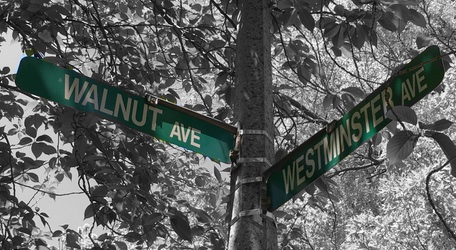
Directions from Sam Adams
The corner of Walnut Avenue and Westminster Avenue is a five-minute drive from the Sam Adams brewery.
From the Brewery, head to Brookside Ave for .2 miles and then turn left onto Cornwall Street. Turn right on Washington Street then immediately take the first left onto Peter Parler Road. At the end of the road, take a left on Walnut Ave. About a 1/2 mile later you'll come to the Westminster Ave intersection.
Walnut Avenue & Westminster Avenue is a 15-minute walk from the Orange Line at the Stoneybrook - Outbound stop.
PermalinkSándor Petőfi Memorial at the Prudential Mall
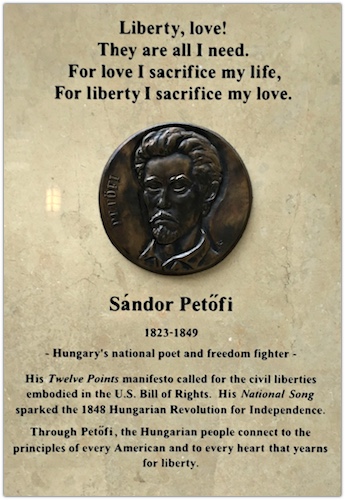
The Prudential Mall is known for it???s fine shopping and dining experience. Did you know tuck away in the Huntington Ave wing is a small memorial for Sándor Petőfi.
This is the only memorial in the entire Prudential Mall. It was placed on March 17, 2013.
Who was Sándor Petőfi?
Sándor Petőfi (1823-1849) was a Hungarian poet and one of the key figures in the Hungarian Revolution of 1848. He is considered Hungary's national poet.
He is the author of the Nemzeti dal, which is said to have inspired the revolution in the Kingdom of Hungary that grew into a war for independence from the Austrian Empire.
Petofi???s lifetime dedication to freedom and democracy make Boston, home of the American Revolution, an appropriate location for this monument.
Why at the Prudential Mall in Boston?
The Consulate General of Hungry is a few steps away from the memorial, they are at 111 Huntington Avenue, Boston, MA 02199.
Many countries have Consulate General in various cities in the United States as they work with the country???s Embassy supporting issues to citizens living in the city or traveling to that city. There are Hungarian Consulates in New York, Los Angeles, Chicago, Houston. The Embassy of the Republic of Hungry is in Washington DC.
Wreath Placements
You may find a flower wreath place at the memorial a few times a year:- January 1st - Sándor Petőfi Birthday
- March 15 - National Day - Memorial day of the 1848 Revolution
- July 31st - Sándor Petőfi Death
Sándor Petőfi Quotes
Here are the quotes that you will find at the top of the memorial:
Liberty, Love!
They are all I need.
For love I sacrifice my life,
For Liberty I sacrifice my love.
The Great Elm Chair
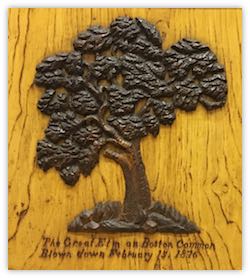
Last week I wrote about some of the historical significance of Boston Great Elm. This week I'll share how you can see and touch a piece of American history, even though the tree fell 139 years ago.
After the tree fell, William W. Greenough had the foresight to do something so people would always remember the tree. He took some parts of the trend made it into a chair. He donated the chair to the Boston Public Library.
The chair ended up in the library because Mr. Greenough was the President of the Board of Trustees of the Boston Public Library. He was a Boston Merchant and Politician.
Boston Public Library - Rare Book Room
Note: The chair is located in the "Special Collections Reading Room" in the Boston Public Library. All visitors to the "Special Collections Reading Room" will need a library card and a photo id to go in. There are some other minor restrictions - no bags or notebooks are allowed in the room. You are allowed to bring in your camera.
The Great Elm Chair is located in the rare book department of the Boston Public Library main branch. This department has the responsibility to preserve all the Boston Public Library rare artifacts. There are lots of very important documents in this department, including William W. Greenough writings, and Koussevitzky works and his desk.
The Department of Rare Books and Manuscripts is located on the third floor of the Research Library. To get to the Rare Book Department, enter the library from Copley Square and go up the grand staircase. Once your on the second floor walk over to the Boylston Room, and on your right you'll see another set of stairs going to the third floor. (Look for signs for the Wiggin or Sargent Gallery) Once on the 3rd Floor, walk through the Wiggin Gallery Door, Through the Music CDs collection and continue walking by the Arts collection.
If you feel lost, simply ask for directions to the Rare Book Special Collection room. Someone will help you get there.
There are two rooms in the Rare Book Department, Special Collections, and Special Collections Reading Room. The Special Collections Reading Room is a limited access room, to get in the room, you need to talk to the person at the desk in the Special Collections. Tell them you are interested in seeing the "Great Elm Chair."
While in the Special Collections room, if you look through the glass doors you may see the Great Elm Chair against the wall. The chair is on wheels and the librarians may move it anytime.
The Great Elm Chair
The Great Elm Chair looks like any fancy wood chair. This particular chair stands out because there is an engraved picture of the Great Elm on the backrest of the chair. Once you see the chair, you have no doubt about what it is.
This is a picture of the chair in the Special Collections Reading Room:
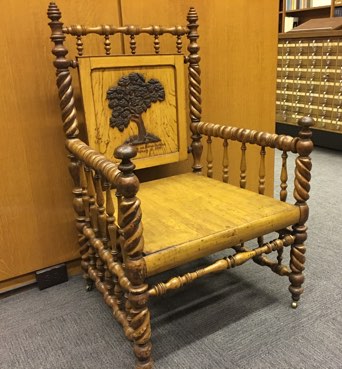 Click on image for a larger version.
Click on image for a larger version.
On the back of the chair there is an engraving plate. The etching has started to fade and it's hard to make out it out. I asked for special permission to use flash on my camera to see if it would help and with some Pixelmator help, I was able to read what it says:

Click on image for a larger version.
This Chair,
made from a branch of the
GREAT ELM ON BOSTON COMMON
which fell in the gale of February 15, 1876,
was given to the Boston Public Library, July 13, 1878,
by WILLIAM W. GREENOUGH.
What's really interesting about this plate is that the words, "Boston Public Library" are in a completely different font style than the rest of the text. Not sure why that would be the case.
Additional Notes
Useless Factoid: The chair is now sitting 1.272 km west of its original location.
The Rare Book Department is only open Monday - Thursday 9 to 5. You can only access the chair when the department is open.
I didn't think about checking to see if there's any special under the seat. If you're going to check out the chair, look under the chair to see if there's anything special under it. Could be a National Treasure Clue or something.
Let me know if you do check out the chair or if this post inspired you to discover a part of Boston that most people wouldn't have known about.
PermalinkBoston's Great Elm

The Boston's Great Elm was a famous tree that stood in the middle of the Boston Commons for about 200 years. It finally came down on February 15, 1876, when it was destroyed by a huge gale storm. The tree was a popular spot for people to visit in the 1800s. It also was part of Boston's early history.
Some Notes about Boston's Historic Tree
Nobody knows when the tree was planted, but rumors suggest that it was planted around the Kings Philip War around 1670 by Capt. Daniel Henchman.
In colonial times, the Boston Commons grounds were mostly a cow pasture. Cows use to lay down underneath the tree to get out of the summer sun.
The Boston's Elm was one of three trees show on early maps of Boston, which was engraved in 1722. The Boston Elm would be the last tree to fall.
Some people confuse the Boston Elm as being the famous Liberty Tree. Actually, the Liberty Tree wasn???t in the Boston Commons. The Liberty Tree was in Hanover Square, which is currently the corner of Essex and Washington Street.
The ???Great Elm??? was known as "Boston Oldest Inhabitant."
Early town records indicate that Quakers and ???witches??? were hanged on its branches. Mary Dyer was one of the colonial American hang from the tree.
The Sons of Liberty hung lanterns on evening during festival occasions.
Citizens use to gather near the tree to protest the British Occupation of the town.
During the early days of the American Revolution, British Solders camp underneath the Elm when they occupied Boston.

In 1825, the tree was measured, 65 feet in height and a circumference of 24 feet 2 inches.
Before the tree came down, a small fence was built around it to prevent people from climbing the tree.
The tree was in tough shape after the storm in 1860 damaged the tree. It was a strong gale wind in a storm on February 15, 1876, that brought down the tree.
After the Boston Elm tree was taken down, a sizable relic was given to the Children's Museum in Jamaica Plain. Note: This is not the Boston Children's Museum. That started out in Jamaica Plain but not until 20 years later.
A chair made of the wood from the Boston Elm is in the rare book room in the Boston Public Library. Worth checking out if you're interested in Colonial Boston history.
Finding the Boston Elm Marker
The Boston Great Elm was located in the middle of Boston Commons, between the Boston Common Visitors Center and Frog Pond. The marker is in the ground. The center of the marker is green surround by light brown cement. (See the picture above)
From the ???Park Street??? T stop, head towards the Brewer Fountain, then head towards the Boston Gardens. You???ll be walking on the ???Mayor???s Walk.??? In about a 100 yards, you???ll come to a walkway intersection. Take a short walk up the grassy hill and you???ll see the marker for the ???Great Elm Site."
The Marker reads:
Site of the Great Elm
Here the Sons of Liberty Assembled
Here Jesse Lee, Methodist Pioneer,
Preached in 1790.
The landmark of the Common, the Elm
blew down in 1876.
Placed by the
N.E. Methodist Historical Society.
X Doesn't Mark the Spot

The Kings Chapel Burial grounds in Boston is the oldest graveyard in Boston. Founded in 1630, at the time of the settlement of Boston, For the first 30 years, it was the only graveyard in the city. The graveyard is not affiliated with any church, it just happens to be next to the Kings Chapel. The Chapel was built in 1688, 53 years after the graveyard was established.
Assorted Facts
- The City of Boston has always owned the graveyard.
- In 1896, a subway ventilation shaft was put in the southwest corner when Boston's subway system became the first in the country. Many gravestones had to be relocated elsewhere in the cemetery.
- There are 600 gravestones and 29 tabletop tombs marking more than 1,000 people buried in the graveyard.
- The last person to be buried in the graveyard is Rhys William in 2003. He was a minister at the First and Second Church in Boston.
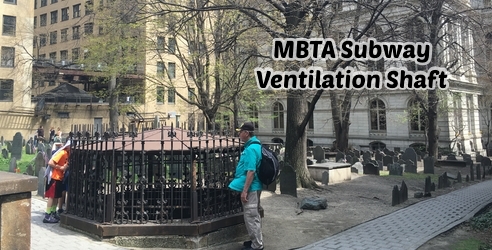
Some Notable People Buried Here
- Sir Isaac Johnson - owned the land and used it for his vegetable garden before it became a burying ground, was the first person to be buried here in 1630.
- John Winthrop - Massachusetts first Governor
- William Dawes - Paul Revere's compatriot on his ride to Lexington in 1775 (Remains we removed in 1882 to)
- Reverend John Cotton - a powerful religious leader in seventeenth-century Boston
- Hezekiah Usher - the colonies' first printer and publisher
- Mary Chilton - who many believe was the first woman to step off the Mayflower.
The Legend of Captain Kidd at the Kings Chapel Burial grounds
Captain William Kidd was a Scottish sailor who was tried and executed for piracy after returning from a voyage to the Indian Ocean.
In 1697, Captain William Kidd was asked by Richard Coote, the Colonial governor of the Massachusetts Bay colony, to catch pirates. Some say that William Kidd might have gone to the dark side and by 1698 was accused of piracy. He was tricked into coming to Boston for clemency and to prove his innocent.
On July 6, 1699, Kidd was arrested. He spent a year at Stone Prison, much of the time in solitary confinement. In early 1700, he was brought to England for inquest and trial. On May 9th, 1700, he was found guilty of murder and on multiple counts of piracy. He was sentenced to death and hanged on May 23, 1701.
Where is Captain Kidd's Buried?
It is very unclear to where Captain Kidd body is after the execution.
There are some legends that say that his body was brought back to Massachusetts and buried at Kings Chapel Burial grounds. His ghost is supposed haunting the Kings Chapel at midnight on Halloween.
Go to the cemetery at midnight, preferably when the moon is dark. Tap softly on one of the headstones three times, and whisper "Captain Kidd, Captain Kidd, for what were you hanged?" And in the dark of the night, Captain Kidd will answer . .
Aside from there being no marker at the Kings Chapel Burial ground, there is no record in the records books of Captain Kidd body coming to America. There is no proof to the story that Captain Kidd body is at Kings Chapel Burial ground. I did read some stories that claim that the British just dump his body in the ocean.
So when you visit the Kings Chapel Burial Grounds on a tour and they mention the Legend of Captain Kidd, you can be sure that it's not true.
Oh, in Massachusetts it's illegal to go to a cemetery after sundown. So the only person answering your tap will be a policeman asking you to leave the cemetery.
PermalinkRivalry (Boston and New York)
When you think of the Boston vs New York rivalry, what comes to your mind?
Red Sox vs Yankees? Patriots vs Jets?
Long before the Babe was traded to the Yankees, there was an engineering rivalry between the two cities. They were both in a race to see which one would be the first to build a successful underground subway system.
It all started after the great blizzard of 1888 hit the Northeast crippling all transportations for many weeks. Politicians in both cities wanted a solution similar to what London was implementing at the time. They wanted to put some of the current transportation structure underground.
Boston
After the legislative approves $5,000,000 for the project, construction began on March 28, 1895. Most of the early construction happened around Boston Commons. There were numerous delays including some issues with finding lots of unmarking graves around Central Burying Grounds. The tunnels were not as deep as the ones in London as the theory was that buildings would hold up better with tunnels not dug too deep. Boston Elevated Railway was the main company that undertook the main part of the project.
The first subway cars left Tremont Station at 8am on September 1st, 1897. Today the MBTA operates 4 Subway lines and 12 commuter rail lines covering 1,193 miles.
New York
While New York wasn't the first subway system, it would be the largest. The New York legislature approved $35,000,000 for initial construction. Once the final plans were in place, construction began on March 24, 1900.
Operation of the subway began at 2:37 pm on October 27, 1904, with the opening of all stations from City Hall to 145th Street on the West Side Branch. Today the has 26 lines and 468 stations in operation; the longest line, the 8th Avenue "A" Express train, stretches more than 32 miles, from the northern tip of Manhattan to the far southeast corner of Queens.
Read More
There's a lot more to talk about the original subway rivalry. Way too much for a weekly Blog posting.
You can read a lot more detail about all the drama that took place during the rush to be the first in The Race Underground: Boston, New York, and the Incredible Rivalry That Built America's First Subway by Doug Most.

Leif Ericsson Statue

There are many monuments and statues around Commonwealth Avenue in Boston. Near the Charlesgate overpass stands a life size statue of Leif Erikson.
Many people believe that Leif Ericsson, a Norse explorer, was the first European to step on North American soil in the year 1000. This theory was made popular in 1838 when the accounts of the journey were translated into English. Once Americans learned about Leif's adventures Leif became popular.
In 1887, Boston philanthropist Eben N. Horsford commissioned the statue. According to various newspaper articles published at the time, the location was selected because that is where he believes where the keel of Erikson's ship grated on the shore of Boston's Back Bay. This was the first Leif Ericsson statue in America.
The statue was created by Anne Whitney, a notable Boston sculptor that also created a duplicate Leif Ericsson statue for Juneau Park, Milwaukee. If you look at Leif Erikson statue's left foot you can see Anne Whitney's name and date of work (1885) . Next to the name is SC - which stands for sculptor.
Statue Information
The statue has the following inscription on the front:
In runic letters, which were used to write various Germanic languages before the adoption of the Latin alphabet:
Leif, son of Erik the Red
On the back, which is slightly hard to read, says:
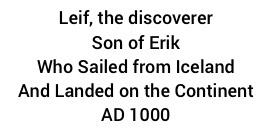
On the right side of the statue is a bronze plaque showing the Ericsson crew landing on the rocky shore.
On the left side of the statue is bronze plaque showing the crew sharing the story of the discovery.
Location
You can find the statue on the Commonwealth Ave. Mall, near Charlesgate East. The best time to see the statue is late afternoon so you can get an unshaded picture of the statue.
 Anne Whitney's name on the Leif Ericsson statue.
Anne Whitney's name on the Leif Ericsson statue.
About
There are many interesting things and places around Boston, MA that you should know about. Here are a few that caught my attention. From historical sites such as the USS Constitution Museum, the Freedom Trail, and the iconic Fenway Park, to modern attractions like the New England Aquarium, the Boston Public Market, and the Isabella Stewart Gardner Museum, there is something for everyone. Whether you are looking for a fun family trip or a romantic getaway, Boston has it all.
Check out all the blog posts.
Schedule
| Saturday | Internet Tools |
| Sunday | Open Topic |
| Monday | Media Monday |
| Tuesday | QA |
| Wednesday | New England |
| Thursday | Gluten Free |
| Friday | Macintosh |
Other Posts
- Coconut Grove Night Club Fire
- Boston Public Gardens Japanese Lantern
- Thompson Island Cemetery
- Leif Ericsson Statue
- Disney World Tribute to Boston History
- Frog Pond
- Nickys Peanut Cart at Fenway Park
- Central Burial Grounds
- Boston Neck 2017
- Massachusetts Law Enforcement Memorial
- Sacco and Vanzetti Plaster Sculptor Mold
- The Christian Science Plaza
- The Great Elm Chair
- Rivalry (Boston and New York)
- Boston Marathon Memorial